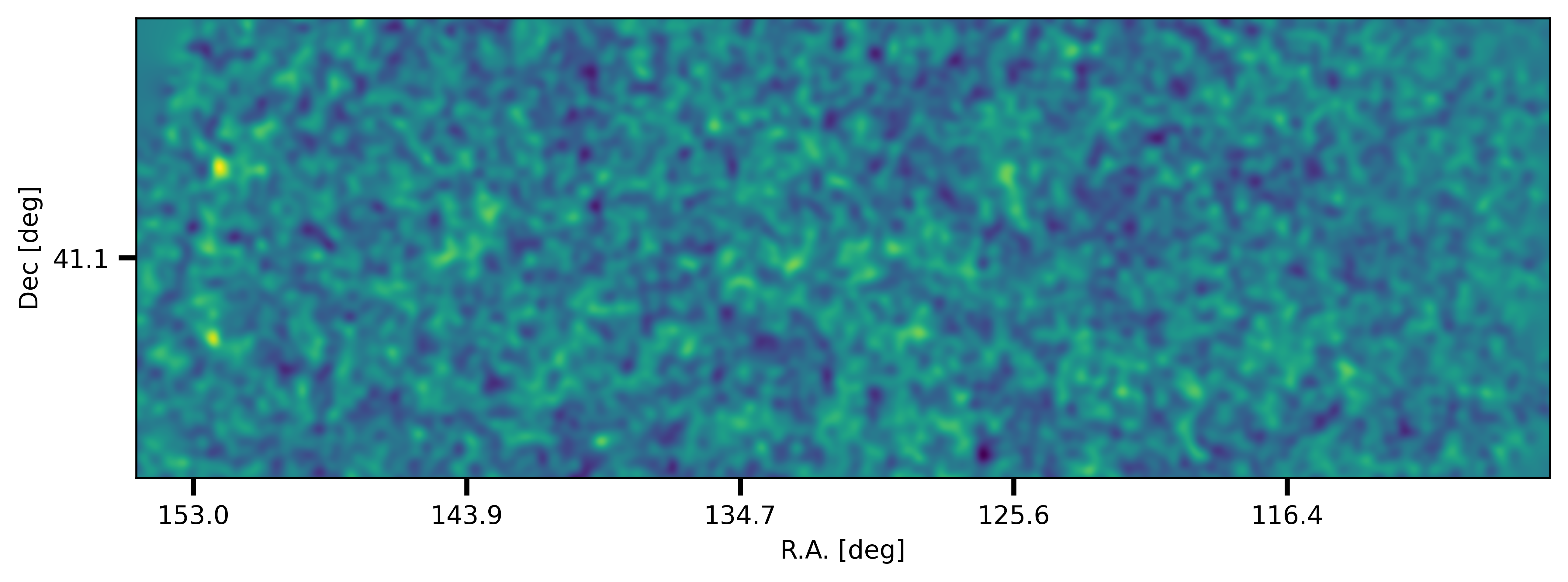
A dark-matter map of the projected cosmic web reconstructed from UNIONS weak-lensing data. This patch located in the Lynx constellation is 275 deg2, which is less than one tenth of the total area observed by UNIONS so far (final coverage will reach 5000 square degrees over the northern sky). Yellow peaks show locations of overdensities corresponding to galaxy clusters, while blue regions correspond to underdense areas, called voids.
Scientists from the CosmoStat laboratory at CEA have produced within the international science collaboration UNIONS (Ultraviolet Near Infrared Optical Northern Survey) a reference catalogue of 100 million gravitationally lensed distant galaxies, one of the largest datasets ever created. This new collection is based on thousands of deep images of the northern sky captured by MegaCam, a large digital camera built at CEA, mounted on the Canada-France-Hawaii Telescope (CFHT). Three new publications present dark-matter mass maps of the cosmic web, showing how the high-density regions in these maps help measure the still poorly known properties of dark matter. In the near future these observations will provide essential support to the European space telescope Euclid. This ESA satellite mission will map the cosmic web over the entire accessible sky at an unprecedented resolution to measure the properties of the mysterious dark energy.
A new milestone has been reached for weak gravitational lensing with the release of one of the largest galaxy catalogues to date. This catalogue contains precisely measured shapes of 100 million galaxies, which trace the slight deformations caused by the gravitational lensing of light travelling throughout the cosmic web of dark matter that permeates the Universe. Modern cosmology requires careful handling of the error budget and comparing catalogues produced through complementary approaches is part of the process. Two versions of the shape catalogue, obtained with different, independent methods, have just been released internally to the Ultraviolet Near Infrared Optical Northern Survey (UNIONS) science collaboration. UNIONS is a large imaging survey of the northern sky in the optical and near-infrared, co-led by Jean-Charles Cuillandre from IRFU/DAp. Three telescopes based in Hawai’i are used to conduct this ambitious survey started in 2017: the Canada-France-Hawaii Telescope (CFHT), Pan-STARRS of the University of Hawai’i, and the Japanese Subaru telescope.

The three telescopes on which the northern sky survey is conducted, from left to right : the Canada-France-Hawaii Telescope (CFHT), Pan-STARRS of the University of Hawai’i, and the Japanese Subaru telescope.
The key cosmology observations were captured at CFHT with the wide-field imaging camera MegaCam, built by CEA twenty years ago (Boulade et al. 2003). MegaCam with its one square degree field of view (four times the size of the full Moon) and 375 million pixels was the largest optical astronomical camera in the world when it saw its first light. Since then it has been surpassed by only four other wide-field cameras (three of which are engaged in UNIONS) and remains at the forefront of science. The superb observing conditions at CFHT atop Maunakea lead UNIONS to an unprecedented collection of galaxies over a very large sky area, making this dataset truly unique. The scientists who produced this new catalogue are now inviting all UNIONS members to exploit this dataset to conduct new science projects.
Under the lead of Martin Kilbinger, one of the two catalogue versions was created over a four-year period by the CosmoStat laboratory (CEA/IRFU/DAp). To process UNIONS data from CFHT, an entire processing pipeline was developed, called ShapePipe. ShapePipe has so far processed a total area sky area of 3,500 square degrees, using more than a million CPU hours and producing 500 terabytes of data; the final weak-lensing data containing 100 million galaxies has a size of 18 gigabytes. The software is modular and has high-performance computation capabilities. It combines state-of-the-art third-party methods with in-house methods developed by CosmoStat. Due to its modular architecture, it is easy to test and implement new algorithms, and can be applied to other weak-lensing surveys. A technical article led by Samuel Farrens, detailing the software, has been submitted to the peer-reviewed Astronomy & Astrophysics journal. CosmoStat has made the code public.
Two science projects led by CosmoStat members and alumni, under the supervision of Kilbinger, using UNIONS weak-lensing data have been published. First, Guinot et al. (A&A article in press) carry out careful testing and validation of the ShapePipe catalogues, and present dark-matter maps and mass profiles of galaxy clusters observed by the ESA satellite mission Planck. This demonstrates the very high quality of UNIONS lensing data, at par or even better than other large surveys such as the KIlo Degree Survey (KiDS) or the Dark Energy Survey (DES), while the sky coverage of UNIONS is still only partial (goal: 5 000 square degrees)
As a second astrophysical application, Ayçoberry et al. (submitted to A&A) examine weak-lensing peak counts as a method to measure cosmological parameters. These peaks trace high-density regions in the cosmic web, the properties of which are very sensitive to the underlying cosmological model. The publication introduced a novel method to explore spatial variations of the lensing calibration, and assesses a variety of uncertainties and systematics that can impact cosmological inference.
Contacts au CEA/DRF/Irfu/DAp
(science lead, data processing)
(French lead of the UNIONS science collaboration)
(weak-lensing software lead)
Other CosmoStat key actors: Axel Guinot (PhD at CosmoStat 2020), Emma Ayçoberry (internship M2 at CosmoStat 2021), Virginia Ajani (PhD at CosmoStat in 2021), Jerome Bonnin (internship M2 at CosmoStat 2019), Tobias Liaudat, Jean-Luc Starck, Lucie Baumont, André Zamorano-Vitorelli, Valeria Pettorino
• Structure and evolution of the Universe › Dark Universe Structure and evolution of the Universe › Evolution of the large structures and galaxies
• Institute of Research into the Fundamental Laws of the Universe • Department of Astrophysics (DAp) // UMR AIM
• Cosmology and Galaxy Evolution • Cosmology and Statistics
• MEGACAM
